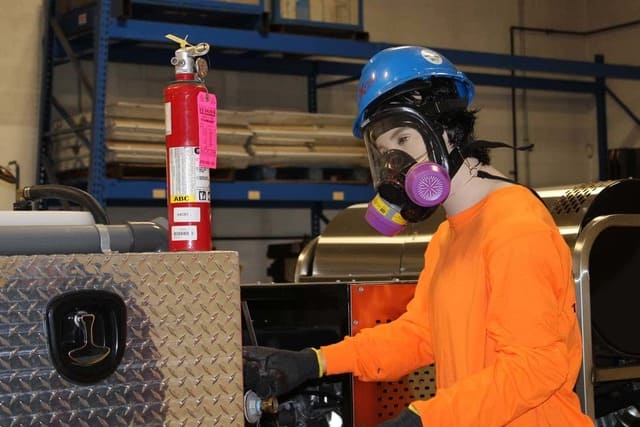The vast majority of portable, handheld fire extinguishers are loaded with a dry chemical powder that will extinguish the majority of fires you might encounter in your daily environment. This powder is not toxic but will make you sneeze and cough if you inhale it. (It tastes like sodium bicarbonate which is its base powder.) This powder will extinguish Class “A”, “B”, and “C” fires.
Class “A” fires involve material such as paper, plastic, wood and other common combustibles.
Class “B” fires involve grease, oil or gasoline. Dry chemical extinguishers will work, but these fires can be harder to extinguish and should be approached with extreme caution.
Class “C” fires involve burning electrical motors or transformer. This type of fire changes from “C” to Class “A” or “B” as soon as the power is cut off (or shorts out). Dry chemical can be used here also because it will not conduct electricity and will put out “A” or “B” type fires.
A dry chemical extinguisher works like most spray paint, hair spray, or shaving cream cans – it does not need to be turned upside down to use it. When a fire emergency calls for its use, remember to sweep the extinguisher’s nozzle back-and-forth at what is burning–not at the flames or smoke. The goal is to put a “barrier” between the fuel and the surrounding oxygen. Don’t empty the extinguisher onto the burned item after the flames are gone. The fire might flare back up and you would be left without any extinguishing powder if it should “re-kindle” or “re-ignite.”
Prior to starting to battle the fire, designate someone to call the fire department. Fire fighters are paid to put the fire out; they know what to do and what to look for–even after you think you have doused it. There have been deaths from fires that were supposedly extinguished but came back to life hours later.
Know where the general use fire extinguishers are throughout your facility or work area. Don’t hang your coat over them, or stack material in front of them. Extinguishers are never needed until they are needed NOW. Keeping them easily visible and easily accessible always helps ensure that when a fire emergency occurs, a fire extinguisher can be easily and quickly reached.
And remember-extinguishers are made for relatively small fires. If the fire is too big or moving too fast to control, hold others away and wait for the Fire Department.

